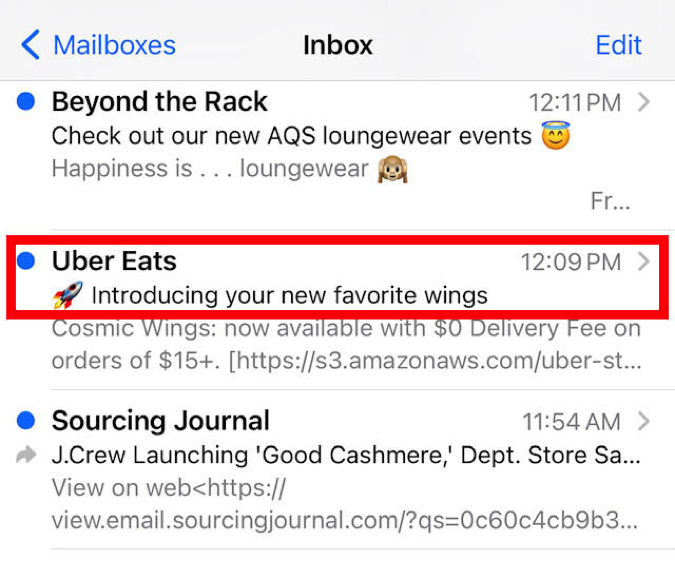An effective subject line is one of the most important decisions you will make: after all, it’s the first thing the reader sees in their inbox. It’s also where you make your first impression, and it should strike enough curiosity to increase your open rates.
What exactly is the open rate? It’s actually a pretty easy concept and the most important to consider. The open rate is measured by the number of opened emails divided by the number of emails delivered to your subscribers. This metric can indicate if your target audience is responding (or not) to your subject line.
So let’s get into it. I’m sure you have seen all types of subject lines, ones that instantly entice while others that make us think, swipe left!
I am going to guide you through the 5 most important factors to creating a high performance subject line. Starting with length.
Keeping it Short
Try to keep it simple and concise, about six to ten words. You may be thinking, why is that important? The answer is simple, over 50% of emails are viewed on a mobile phone. When viewing an email on a phone, words will easily get cut off if the subject line is too long. Although that might not apply if your readers are browsing their inbox on a desktop computer, just remember over a billion people use their phones to check their email.
Beware of Those Trigger Words
Think about the words you want to include before setting up your subject line. The problem is, most marketers just write what feels good forgetting that there is a formula to great subject lines. Some are great, some are terrible and some are downright not allowed. Especially when it comes to words that are considered spam by email filters.
According to Statistica, spam messages represented 47.3% of email traffic in September 2020. This may be a bit scary when you factor in how many of us hardly check our spam folders. Yikes.
And then there are the words that make you seem desperate, illegitimate, and just…a little forceful. These types of words may include “Call here”, “Buy”, “Act now”, “Apply now” or just a simple $ sign.
Try to weed out which words can affect your credibility and, of course, your visibility – avoid landing in that spam folder!
I have provided with a few examples of excellent subject lines from Sumo showing significant open rates.
When Using the Emoji in a Subject Line
There may be hesitation when it comes to including an emoji in a subject line. Understandable. However, if used carefully with the right words (and your selected target audience), the outcome can be crazy positive.
According to Experian, open rates increased by 56% when using emojis in a subject line. A study from Econsultancy has also gathered that using emojis was effective by 60%.
Here is an example from my own experience. In this email I received from Uber Eats, they decided to include the rocket ship emoji instead of using the words “launching” when introducing their new wings. It’s short, relevant, and catchy.
Heads up! If you decide to use an emoji, try keeping it to only one. You wouldn’t want to overwhelm the look of your subject line.
Preview Text and its Value
As much as the subject line is important, so is the preview text.
The preview text is what comes after the subject line – it’s a snippet of the first words in your email template. Since the preview text has a little more real estate than the subject line, this is where you will want to grab your readers’ attention.
According to Spearmarketing, writing an engaging and relevant preview text can increase your click-through rates by 30%. So make it count!
A click-through rate (CTR) is the number of users who have clicked on a link in your email.
In this example, Optinmonster has included a call-to-action as text, which engages readers to open the email to find the link.
Having a call-to-action in your email is a great way of tracking if you’ve sparked enough interest in your readers to take the next step.
The Wonders of A/B Testing
On to testing!
Email marketing platforms such as Mailchimp and Campaign Monitor allow you to perform A/B testing by splitting your subject line into two variations in a campaign. When starting, it’s suggested to test out 50% of your list only. For example, 25% will be sent to variation A, while 25% to variation B.
A/B testing will help verify if your subject line is receptive to your readers by determining your open and click-through rates. According to Campaign Monitor, an incredible 39% of brands don’t test their transmission or fragmented messages.
In essence, doing A/B testing and knowing your results will pave your way to success over your competitors.
At the End of the Day
When dreaming up your next high performance subject line it is important to stay laser-focused on your strategy. By focusing on relevancy, choosing the right words, selecting the right emoji, and crushing that preview text you will have a far better chance of getting your readers to open your emails. But don’t forget to test, test and then retest. Consumers habits change constantly and you’re A/B tests will be a first line of defense in understanding their shifting tastes and behaviours. Mailchimp and Campaign Monitor will help you achieve that success by providing the metrics that ensure the highest performing subject and preview text are served to your target audience. But here is the real secret. Creating a stellar subject line comes down to taking risks and then letting your audience vote with their clicks.
So get out there and try something crazy!
Have a cool subject line you want to share? Need help creating a higher performing subject line? Contact us! We would love to chat.
—–
Article Written by:
Sharon Espinal
Content and Digital Marketing Specialist | Digital Marketing Collective









